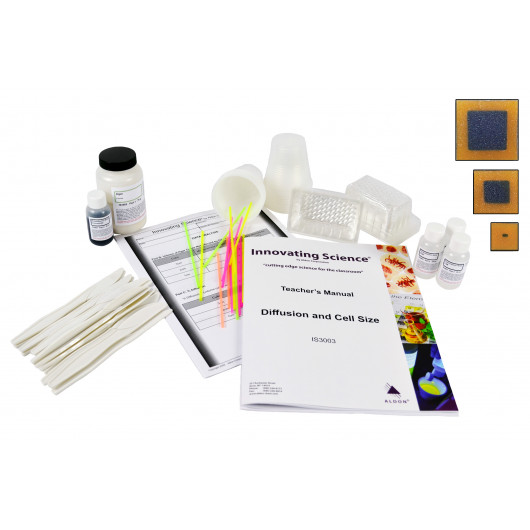Genetics of Blood Types SKU: ALD3102
Students will learn about the genetics that determine blood type and the possible inheritance patterns and how they express themselves.



Why are cells microscopic? The answer relates to the needs for the cell to effectively move materials in and remove waste. In this activity, students will create simulated cells (agar blocks) of different sizes and examine how effectively a substance is able to diffuse into the cell in a set period of time.
| Item | Price | Qty | ||
|---|---|---|---|---|
| Small Group Learning, Diffusion and Cell Size | ALD3003-SGL | $20.75 | ||
A special indicator in the cells will allow students to visualize the degree of diffusion. The results will clearly display the fact that a smaller volume creates a more favorable condition for the exchange of material across a cell membrane. Kit contains enough materials for 15 groups of students. Teacher’s Manual and Student Study Guide copymasters are included.
Aligned to the Next Generation Science Standards (NGSS)*
Disciplinary Core Ideas: LS1.A
Performance Expectations: MS-LS1-1; MS-LS1-2
Cross Cutting Concepts: Scale, Proportion, and Quantity Structure and Function
Engineering Practices: Developing and Using Models; Planning and Carrying Out Investigations
Kit Includes:
Regulatory Note: Small Qty Exemption 49CFR173.4
*”Next Generation Science Standards” is a registered trademark of Achieve. Neither Achieve nor the lead states and partners that developed the Next Generation Science Standards was involved in the production of, and does not endorse, this product.
![]() WARNING: This product can expose you to chemicals, which are known to the State of California to cause cancer, birth defects and reproductive harm. For more information go to www.P65Warnings.ca.gov.
WARNING: This product can expose you to chemicals, which are known to the State of California to cause cancer, birth defects and reproductive harm. For more information go to www.P65Warnings.ca.gov.
You are sent a comment success. The administrator will review and approve your comment. Thank you!
Students will learn about the genetics that determine blood type and the possible inheritance patterns and how they express themselves.

Why are cells microscopic? The answer relates to the needs for the cell to effectively move materials in and remove waste. In this activity, students will create simulated cells (agar blocks) of different sizes and examine how effectively a substance is able to diffuse into the cell in a set period of time.